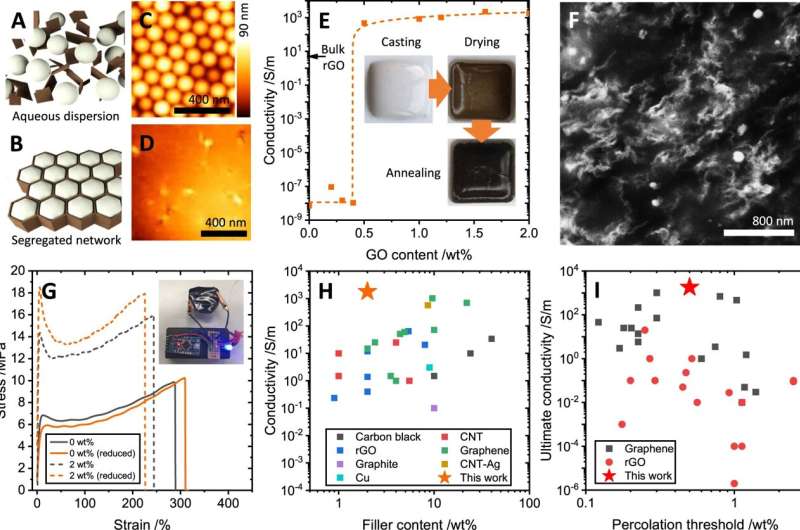How the science behind epidemics helped physicists develop state-of-the-art conductive paint

In new research published in Nature Communications, University of Sussex scientists demonstrate how a highly conductive paint coating that they have developed mimics the network spread of a virus through a process called 'explosive percolation'—a mathematical process which can also be applied to population growth, financial systems and computer networks, but which has not been seen before in materials systems. The finding was a serendipitous development as well as a scientific first for the researchers.
The process of percolation—the statistical connectivity in a system, such as when water flows through soil or through coffee grounds—is an important component in the development of liquid technology. And it was that process which researchers in the University of Sussex Material Physics group were expecting to see when they added graphene oxide to polymer latex spheres, such as those used in emulsion paint, to make a polymer composite.
But when they gently heated the graphene oxide to make it electrically conductive, the scientists kick-started a process that saw this conductive system grow exponentially, to the extent that the new material created consumed the network, similar to the way a new strain of a virus can become dominant.
This emergent material behavior led to a new highly-conductive paint solution that, because graphene oxide is a cheap and easy to mass produce nanomaterial, is both one of the most affordable and most conductive low-loading composites reported. Before, now, it was accepted that such paints or coatings were necessarily one or the other.
Electrically conductive paints and inks have a range of useful applications in new printed technologies, for example by imparting coatings with properties such as anti-static or making coatings that block electromagnetic interference (EMI), as well as being vital in the development of wearable health monitors.
Alan Dalton, Professor of Experimental Physics, who heads up the Materials Physics Group at the University of Sussex explains the potential of this serendipitous finding: "My research team and I have been working on developing conductive paints and inks for the last ten years and it was to both my surprise and delight that we have discovered the key to revolutionizing this work is a mathematical process that we normally associate with population growth and virus transmission."
"By enabling us to create highly-conductive polymer composites that are also affordable, thanks to the cheap and scalable nature of graphene oxide, this development opens up the doors to a range of applications that we've not even been able to fully consider yet, but which could greatly enhance the sustainability of Electric Vehicle materials—including batteries—as well as having the potential to add conductive coatings to materials, such as ceramics, that aren't inherently so. We can't wait to get going on exploring the possibilities."
Dr. Sean Ogilvie, a research fellow in Professor Dalton's Materials Physics Group at the University of Sussex, who worked on this development adds, "The most exciting aspect of these nanocomposites is that we are using a very simple process, similar to applying emulsion paint and drying with a heat gun, which then kickstarts a process creating chemical bridges between the graphene sheets, producing electrical paths which are more conductive than if they were made entirely from graphene."
"The growth of this network is analogous to the emergence of high-transmission viral variants and could allow us to use epidemic modeling to develop exciting new materials or even materials to understand epidemic transmission."
About the experiment
The scientists took polymer latex spheres and added graphene oxide. Through drying this solution, as you would dry paint, the graphene oxide becomes trapped between the spheres and as more graphene is added, the sheets eventually form a 'percolating' network within the latex film.
However, because graphene oxide isn't electrically conductive, the scientists performed some mild heating to eliminate chemical defects (150 C, similar to the temperature of a heat gun used to dry paint). When they did this, they found that the films not only become conductive—as expected—but became more conductive than if they were made entirely from the graphene.
The reason for this is that the sheets are trapped together between the latex spheres (rather than randomly arranged), the mild heating kick-starts chemical modification of the graphene which in turn chemically modifies the polymer to produce small molecules which crosslink (form chemical bridges between) the sheets which dramatically increases their conductivity.
This phenomenon where, only at the point of percolation, the materials go through a 'phase transition' to form a completely different network than if they weren't connected is known as 'explosive percolation.' It can be thought of reaching a critical level of connectivity where the new material grows explosively through the network.
The full paper is published in Nature Communications.
More information: Manuela Meloni et al, Explosive percolation yields highly-conductive polymer nanocomposites, Nature Communications (2022). DOI: 10.1038/s41467-022-34631-9
Journal information: Nature Communications
Provided by University of Sussex





















